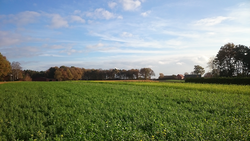We want to understand how microbial diversity and ecosystem functions are linked and change through agriculture. That is why we are studying the genetic material (DNA) of the soil, the so-called metagenome.

Classical microbiological methods, as they were common for soil investigations until the end of the 1980s, only capture about 0.1 per cent of the microorganisms that occur in soils, thus overlooking the most important players. However, new highly efficient DNA sequencing techniques, like those used to decode the human genome, now make it possible to capture the entire microbial diversity. To do this, DNA is extracted from soil samples and purified.
And the speed and precision with which soil DNA can be sequenced continues to increase. Whereas just a few years ago only a few hundred genes could be detected from bacteria in a soil sample within an entire research project, today we can already detect several million genes in a single analysis in just a few days.
However, in order to understand the information stored in the genes, new methods and know-how are needed, especially from the field of bioinformatics. That is why our research team at the Thünen Institute for Biodiversity combines the fields of ecology, microbiology and bioinformatics. This is the key to understanding the new methodological potentials for characterising microbial diversity and its variability as a consequence of e.g. tillage or climate change, and to develop recommendations for protecting its positive ecosystem services.
Which microoganisms are being lost, which are being added?
After all, we can only protect what we know - and the protection of our soils is becoming increasingly urgent. Due to global population growth and the simultaneous dramatic loss of fertile soils through erosion and salinisation, more and more productivity will have to be achieved on less and less arable land in the future. When natural areas such as forests are cleared for agriculture, this has enormous consequences for soil microbiological diversity. In current research, we are determining which microorganisms are lost in such changes and which new ones are added.
Can the spread of harmful microorganisms be prevented by clever soil cultivation? If you change the crop regularly, different microorganisms keep accumulating in the soil influenced by the root, the so-called rhizosphere. This increases biodiversity and is bad for specialised pests.
How do microbial communities come together to form functional units in the soil, and what influences change them? What is the relationship between the individual species of a community, and are there species that are more important and possibly more sensitive than others? What are the short-term and long-term effects of soil amendments on the interaction of bacteria, archaea and fungi? To answer these questions, we at the Thünen Institute have developed and evaluated methods to analyse soil metagenomes from individual soil aggregates (which are soil quantities in the milligram range). These so-called aggregatomes are the key to identifying networks and interactions of microorganisms that were previously unknown but are extremely important for the function of soils.
Research on genetically modified plant varieties
In order to determine the effects of genetically modified plants on soils, we study the bacterial diversity in the rhizospheres. Whereas until a few years ago we were hardly able to determine differences between genetically modified plants and their conventionally bred parent plants, today we are indeed able to detect differences using the most modern, highly sensitive molecular methods. However, in the plants examined so far, these differences were smaller than those between normal, conventionally bred varieties.
This means that every plant variety, whether genetically engineered or conventionally bred, has a characteristic bacterial community in its root zone. Deviations are therefore natural. However, for each new genetically modified plant we would like to understand more precisely which bacteria are promoted by a genetic modification and which, if any, are also inhibited. To answer this question, we will need field trials in the future, because the conditions of cultivation in the laboratory or greenhouse differ, and the soil bacteria probably react differently there.
How does biological plant protection affect soil microbiomes?
Biological plant protection may reduce the use of chemical pesticides in the future. This can potentially promote or maintain biodiversity in agroecosystems in a sustainable way.
We are using our expertise in characterizing soil microbiomes more precisely than ever before to assess the impact of new biological products on soil microbiomes. This is being done using bacteriophages, viruses which are targeted against plant-damaging bacteria and which can eliminate them by infection. However, close relatives of such harmful bacteria can also occur naturally in soil microbiomes, and there is no reason to inadvertently harm them as well. Previous results show that bacteriophages are very specific. Thus, they have less impact on non-target organisms than many chemical products.
Publications
- 0
Liu B, Arlotti D, Huyghebaert B, Tebbe CC (2022) Disentangling the impact of contrasting agricultural management practices on soil microbial communities - Importance of rare bacterial community members. Soil Biol Biochem 166:108573, DOI:10.1016/j.soilbio.2022.108573
- 1
Szoboszlay M, Tebbe CC (2021) Hidden heterogeneity and co-occurrence networks of soil prokaryotic communities revealed at the scale of individual soil aggregates. Microbiol Open 10(1):e1144, DOI:10.1002/mbo3.1144
- 2
Krause SMB, Näther A, Ortiz Cortes V, Mullins E, Kessel GJT, Lotz LAP, Tebbe CC (2020) No tangible effects of field-grown cisgenic potatoes on soil microbial communities. Front Bioeng Biotechnol 8:603145, DOI:10.3389/fbioe.2020.603145
- 3
Szoboszlay M, Näther A, Mullins E, Tebbe CC (2019) Annual replication is essential in evaluating the response of the soil microbiome to the genetic modification of maize in different biogeographical regions. PLOS One 14(12):e0222737, DOI:10.1371/journal.pone.0222737







